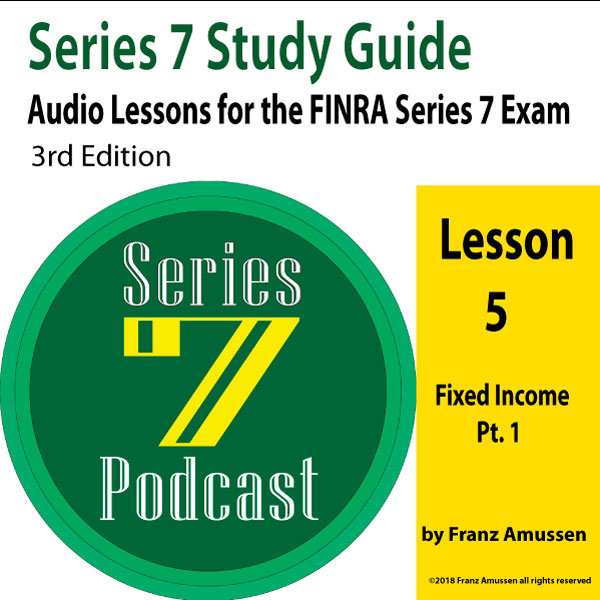Podcast: Play in new window | Download (Duration: 29:15 — 20.2MB)
Series 7 Study Guide Lesson 5
 This is Series 7 Study Guide Lesson 5 the first episode covering fixed income investments. They are different from equities. I’ve always told people that there are only two types of investments in this world. There’s equity which is the owners and there’s debt which are the loaners. The owners and the loaners – these are the only two types of investments.
This is Series 7 Study Guide Lesson 5 the first episode covering fixed income investments. They are different from equities. I’ve always told people that there are only two types of investments in this world. There’s equity which is the owners and there’s debt which are the loaners. The owners and the loaners – these are the only two types of investments.
Wall Street comes out with all sorts of arcane strategies, but when it really comes down to it you’re either a lender or an owner. Now, you have options which are speculations and you have commodities that are speculations and both can offer hedges which can protect your securities or protect your portfolio sometimes, but not all the time. But these are not investments; these are different strategies that you use as an investor to do other things with your portfolio.
But there are really only two types of investments. There’s equity, and we’ve had three episodes of equities. We’ve had common stocks, we’ve have preferred stocks and then we’ve had special securities which covered rights warrants and ADRs (American Depository Receipts). This is the first one that’s really specifically dealing with fixed income investments.
When you buy a fixed income investment, it has a stated par value. We’ve talked about this in common and preferred stocks. But in fixed income investments this is the face value of the bond, or the Ginnie Mae, or the Fannie Mae, or the government bond, or the government bill, or the government note. These are all fixed income investments, but they all come with a par value, a stated maturity value. This is what you’re going to get when it matures. This is assuming that you’re buying a bond or fixed income investment in a company that can actually pay off the bond. In the case of government bonds, they are considered risk-free. It’s the only risk free investment out there. Now, we could get into a big discussion on that, but were not going to because what’s safe is a matter of interpretation.
Par value or maturity value is what they (fixed income investments) will mature at. They come with a stated interest rate which is stated on the par value. But there’s an exception to this and that is the zero coupon bonds. They are a special case and we’ll be talking about those. There’s also a stated maturity value. This is a date when you get back your par value or your maturity value on the fixed income investment.
There are a few other things that can be added into fixed income investments. These are call features just like in preferred stocks. Fixed income securities have call features or may have call features. The exception that you can usually count on are government bonds. US government bonds have no call features. They may have sinking funds which are simply a portion of money set aside every year to buy back the bonds. These are usually found in municipal fixed income investments or municipal bonds.

